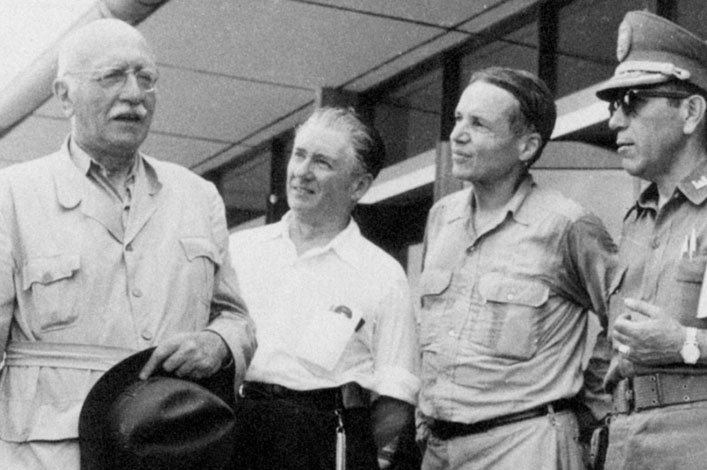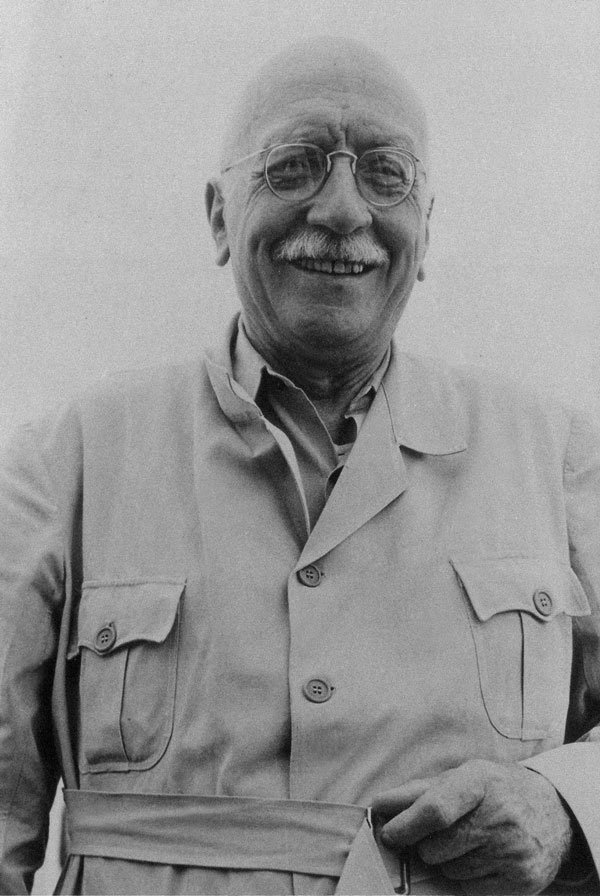
Author: Peter Kramer
Who were the people who joined forces in the 1950s and created an organization with the aim to set up a research station on the Galapagos Islands? I was able to know some of them when I started working as a biologist and conservationist in the 60s and 70s. At the time, I did not really understand the great significance of what they had accomplished. Most of them were scientists, some specifically evolutionary scientists, some were leaders of important scientific institutions, and all of them had traveled and done work in the tropics. While some had never been on Galapagos, they all, of course, understood the role Galapagos had played in Darwin’s thinking.
It seems that the creation of the Charles Darwin Foundation (CDF) happened as part of a general post World War II movement to set up international conservation organizations. In fact, when looking at the list of founding CDF members it becomes clear most of them knew each other as colleagues working in these organizations. The members of our founding Executive Council (equivalent to what now is our Board) were: Julian Huxley (Honorary President), Victor Van Straelen (President), Luis Jaramillo (Vice-President), Jean Dorst (Secretary General), Robert Bowman (Secretary for the Americas), as well as Jean-Georges Baer, Cristobal Bonifaz Jijón, Francois Bourliere, Harold Coolidge, Bernhard Rensch, Dillon Ripley, Peter Scott and Willian Randolph Taylor.

Looking at the biographies of these people it becomes clear that the Galapagos project was only one of several international conservation initiatives they took. Most of them are also found on the leadership lists of UNESCO, IUCN, WWF, all were founded after World War II, and of the International Council for Bird Preservation (ICBP), today “Birdlife International”, the first international conservation organization, created in 1922. These people understood that dramatic intensification of land and resource use, environmental pollution, combined with explosive population growth and our tragic tendency to regularly slide into armed conflicts, led to massive destruction of natural habitats everywhere around the world. The organizations they set up brought together governments, NGOs and individuals from western and eastern countries at a time when the Cold War dominated the international political climate, leading to proxy wars in many parts of the world. They understood that a movement to achieve conservation and protect species and ecosystems needed three ingredients: international cooperation, good science and serious financial investment.
The team of our founders consisted exclusively of Western Europeans and US-Americans, who, in order to address the Galapagos problem, invited and integrated two Ecuadorian diplomats into the group. The idea was that the Europeans and US-Americans should bring in the funding, mainly from scientific institutions, and the Ecuadorian diplomats would ensure political support in their country. It is unlikely there was any consideration to invite representatives of the Eastern Bloc to join the initiative, even though these countries were very much involved in UNESCO and IUCN. Galapagos was part of Ecuador, which belonged to the Western Hemisphere making it unlikely Soviet institutions would have contributed financially. It is also possible I think that the focus on evolutionary science and the celebration of Charles Darwin, central to the Galapagos venture, would not have been accepted by Soviet institutions. The Communist ideology at the time rejected Darwin’s and Mendel’s ideas explaining evolution and genetic inheritance. I find this interesting because, only some 80 years earlier, Karl Marx had been an admirer of Charles Darwin and his work. In fact, Marx dedicated and sent a copy of “Das Kapital” to Darwin and asked for his endorsement. Darwin politely declined, saying that he was not familiar enough with Marx’ area of work to comment authoritatively! It appears the two had a very friendly correspondence - only half a century before Marx’ Dialectic Materialism became the philosophical basis for the communist revolutionary movement in Russia and for the communist regime in that country. But starting in the nineteen twenties that regime strongly rejected Darwin’s ideas and Mendelian genetics and believed that environment-induced changes are the primary mechanisms of heritability. This ideology, resembling the ideas of Lamarck and put forward by Trofim Lysenko, prevailed in the Soviet Union well into the Sixties making it very unlikely that Soviet scientists or institutions would have associated with an organization named after Charles Darwin.
The founders of the Charles Darwin Foundation, in their roles as leaders of ICBP, UNESCO, IUCN and WWF, had the entire world in mind. Yet, with the creation of the Darwin Foundation, they were geographically very focused, aiming exclusively on the conservation of Galapagos, facilitated by the establishment of a field research station. Of course, ours was not the first such station. A number of similar institutions had been set up around the world over the course of the past century. I am sure that existing stations, such as the one in Woods Hole, Massachusetts, and the one in Naples, Italy, served as models. Julian Huxley had worked at the Naples Zoological Station as a young man, and I imagine the idea to fund a Galapagos research station by having major scientific organizations around the world pay annual fees for “research tables” followed the model of the Naples Station. More significantly, though, Julian Huxley was the leading scientific authority reconciling Darwin’s theory with Gregor Mendel’s ideas on heredity into a joint theoretical framework. In addition, Julian Huxley was a grandson of Thomas Henry Huxley, the friend and promoter of Charles Darwin, as well as the first Director General of UNESCO. Clearly, he was predestined for leadership in the campaign to establish the Galapagos research station.
Almost all other founding members of the CDF were, like Huxley, “heavyweights” in scientific and government institutions in the US, UK, France and Belgium. They did not have much first-hand experience on Galapagos, with the exception was Bob Bowman, who was the youngest, had done research on the Islands and had written a report to UNESCO. Bernhard Rensch was and remained for a long time the only German in these circles. He was an evolutionary scientist and, like Huxley, one of the early architects of the synthesis of Darwin’s ideas about natural selection with Mendelian genetics. Rensch became prominent after the war, after having been professionally marginalized by the Nazi party in the Thirties because he refused to join the party. That probably gave him additional standing after the war.
Bringing Luis Jaramillo and Cristobal Bonifaz into this group of pioneers was a brilliant move. The former was Ambassador of Ecuador to UNESCO, the latter Ambassador of Ecuador to France. They both actively supported the research station idea. Cristobal Bonifaz was absolutely instrumental in promoting the project within the Ecuadorian government. He also provided guidance and support to Jean Dorst during his mission at the end of 1958, as well as to all CDF Directors during the Sixties and Seventies.
A look at the history of science on Galapagos shows that our founders were not the first ones pursuing the establishment of a Galapagos research station. I asked myself why earlier initiatives were unsuccessful. I was thinking, for example, of the initiative taken by the California Academy of Sciences, whose 1905/6 Galapagos expedition had produced the most comprehensive collection and descriptions of Galapagos flora and fauna to date. The Academy had proposed a Galapagos research station in the thirties, a proposal made to the Ecuadorian government via the then Ecuadorian Consul in California, C.M. Egas. The initiative produced Ecuadorian legislation in August 1934: An executive order banning the export of protected animals and creating reserves on many islands. It did not lead to any concrete action on the ground.
Then there was Victor von Hagen, who had promoted the idea to establish a research station on Galapagos. He had led an expedition to Galapagos in 1935 to commemorate the 100th anniversary of Darwin’s visit to Galapagos and had commissioned the creation of Darwin busts on that occasion. One bust was set up in Puerto Baquerizo Moreno and the other one in Quito, where they still can be seen. The Darwin anniversary led to a government decree in 1936 establishing general protection of the Islands’ Flora and Fauna and declaring that a research station was to be set up there. A series of postal stamps were published on that occasion. It is not clear whether von Hagen really had anything to do with that decree and the stamps, although he claims to have triggered all of it. He certainly did promote the idea in Ecuador to permanently establish a scientific presence on the Islands. He later notes that he wrote to every institution in America he could think of to ask for advice and to secure support for that idea. No one showed interest.
Von Hagen’s activities surely made Charles Darwin better known in Ecuador, I assume they promoted in Ecuador a clearer understanding of the Islands’ exceptional value. Galapagos started to be seen as a scientific treasure rather than a destination for criminals and political opponents or a territory that could potentially be sold or leased. Still, these decrees, declarations, busts and stamps had no effect on what actually happened on the Islands. This was because the World War imposed different priorities, although I suspect it was also because there was no structure or organization that could have taken up and managed Von Hagen’s or any other initiative. Von Hagen was not involved in setting up the CDF; a later initiative to bring him into the organization was blocked because members of the CDF Board considered him an “untrustworthy fellow”. He was linked with the illicit sale of Ecuadorian archival material from Quito that had disappeared and then reappeared in a London antique book dealer’s shop. This allegedly led to him being regarded as persona-non-grata in Ecuador.
Another initiative came from Waldo Schmitt, a Smithsonian Institution biologist, who accompanied President Roosevelt in 1938 on a cruise through the Galapagos and later investigated, on behalf of the US Navy, the possibility to set up a research station there. These plans also never materialized. Instead, the US Government worked out an agreement with the government of Ecuador allowing them to establish, in 1941, a large US military base on Baltra to keep the Japanese away from that part of the Pacific and particularly from the Panama Canal.
Another scientist had advocated Galapagos protection and had proposed the establishment of a research facility during the Thirties: Misael Acosta Solis. He was the most accomplished Ecuadorian biologist during the 1930s, 1940s and beyond. Acosta Solis was a pioneering botanist and soil ecologist focusing on mainland Ecuador. He had visited Galapagos in 1937 and had published papers on the flora of the Islands. He was the first Ecuadorian Biology Ph.D., had studied and worked in the US, taught in Ecuadorian universities, and was instrumental in setting up institutions managing soil and forest policies in Ecuador. While I was CDF Director, I went to visit Acosta Solis in his house in the old center of Quito in 1972. He was deeply involved in research on the Ecuadorian continent, regretted to have no formal connection to the Darwin Foundation, but supported its activities.
My conclusion is that the successful creation of the Darwin Foundation in the nineteen fifties was owed to the focus and dedication of a small, self-selected group of men* with influence in the right places. The political and financial clout of UNESCO was critically important, as well as connections to other funding sources in the US and Europe. Also, nothing would have worked without political and social standing and influence within Ecuador.
*Yes, they all were men, as usual at the time! I did find, however, that there was one woman who seemed, in the background, to have played a significant role in taking the Darwin Foundation project forward: Marguerite Caram, Assistant Secretary General of IUCN. She participated in preparatory meetings, was not invited to join the CDF Board and left her IUCN position in 1958. I imagine things would not have moved without her!





